key Alfa Romeo 166 2006 Owner handbook (in English)
[x] Cancel search | Manufacturer: ALFA ROMEO, Model Year: 2006, Model line: 166, Model: Alfa Romeo 166 2006Pages: 272, PDF Size: 4.17 MB
Page 108 of 272
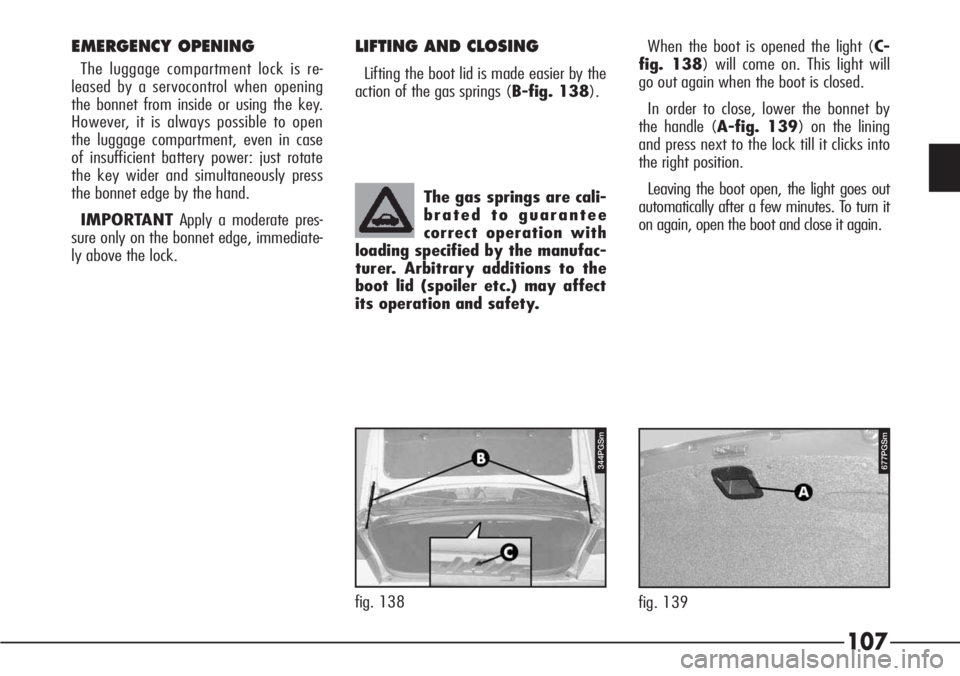
107
The gas springs are cali-
brated to guarantee
correct operation with
loading specified by the manufac-
turer. Arbitrary additions to the
boot lid (spoiler etc.) may affect
its operation and safety.
EMERGENCY OPENING
The luggage compartment lock is re-
leased by a servocontrol when opening
the bonnet from inside or using the key.
However, it is always possible to open
the luggage compartment, even in case
of insufficient battery power: just rotate
the key wider and simultaneously press
the bonnet edge by the hand.
IMPORTANTApply a moderate pres-
sure only on the bonnet edge, immediate-
ly above the lock.
LIFTING AND CLOSING
Lifting the boot lid is made easier by the
action of the gas springs (B-fig. 138).When the boot is opened the light (C-
fig. 138) will come on. This light will
go out again when the boot is closed.
In order to close, lower the bonnet by
the handle (A-fig. 139) on the lining
and press next to the lock till it clicks into
the right position.
Leaving the boot open, the light goes out
automatically after a few minutes. To turn it
on again, open the boot and close it again.
fig. 139
677PGSm344PGSm
fig. 138
Page 114 of 272
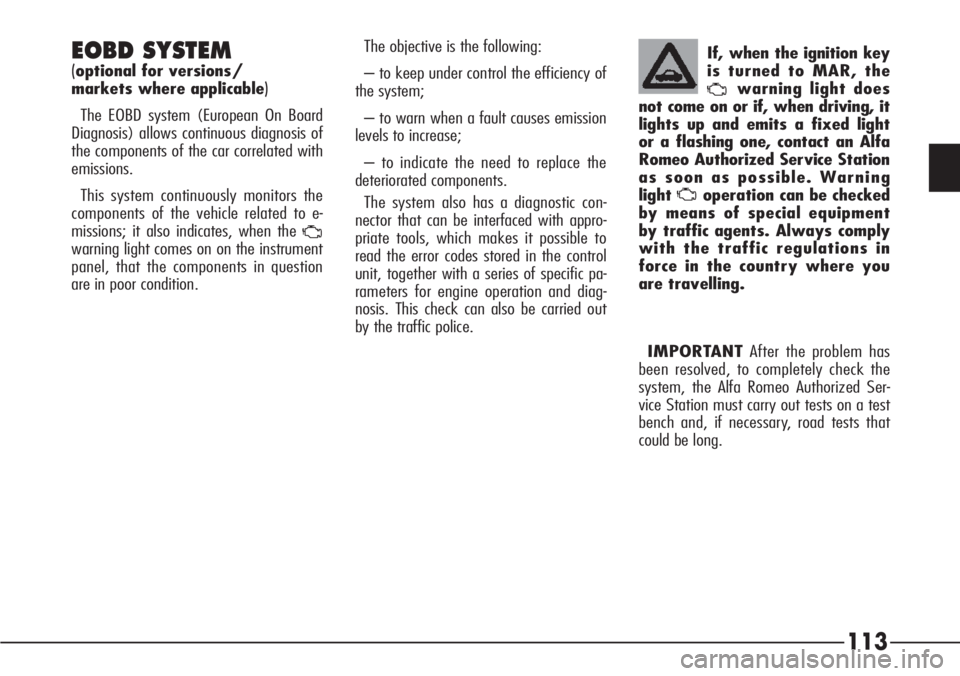
113
EOBD SYSTEM
(optional for versions/
markets where applicable
)
The EOBD system (European On Board
Diagnosis) allows continuous diagnosis of
the components of the car correlated with
emissions.
This system continuously monitors the
components of the vehicle related to e-
missions; it also indicates, when the
Uwarning light comes on on the instrument
panel, that the components in question
are in poor condition.
IMPORTANTAfter the problem has
been resolved, to completely check the
system, the Alfa Romeo Authorized Ser-
vice Station must carry out tests on a test
bench and, if necessary, road tests that
could be long.If, when the ignition key
is turned to MAR, the
Uwarning light does
not come on or if, when driving, it
lights up and emits a fixed light
or a flashing one, contact an Alfa
Romeo Authorized Service Station
as soon as possible. Warning
light
Uoperation can be checked
by means of special equipment
by traffic agents. Always comply
with the traffic regulations in
force in the country where you
are travelling.
The objective is the following:
– to keep under control the efficiency of
the system;
– to warn when a fault causes emission
levels to increase;
– to indicate the need to replace the
deteriorated components.
The system also has a diagnostic con-
nector that can be interfaced with appro-
priate tools, which makes it possible to
read the error codes stored in the control
unit, together with a series of specific pa-
rameters for engine operation and diag-
nosis. This check can also be carried out
by the traffic police.
Page 122 of 272
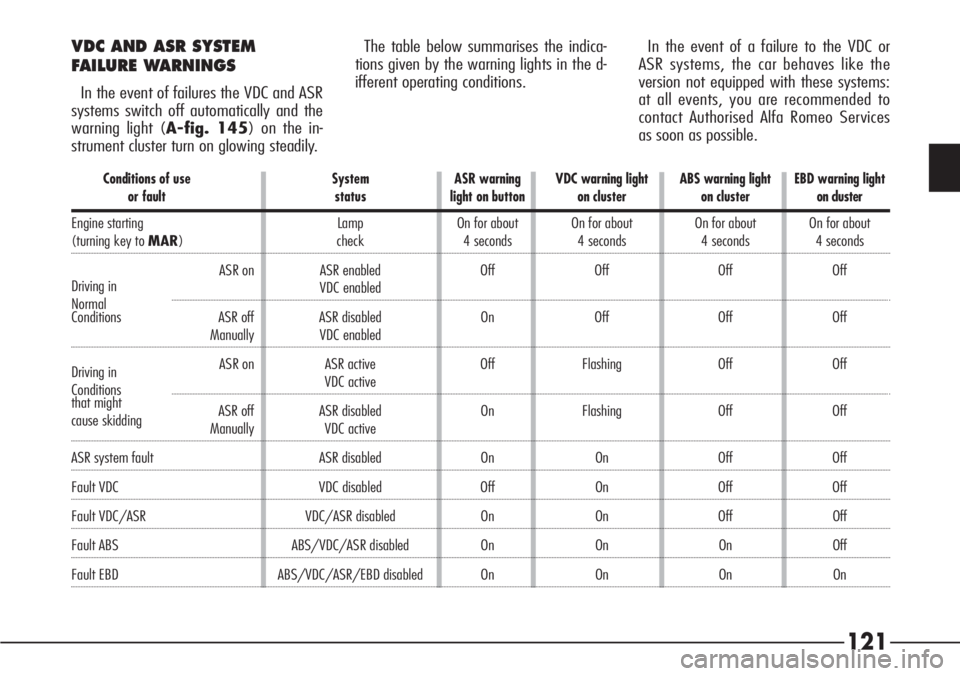
121
VDC AND ASR SYSTEM
FAILURE WARNINGS
In the event of failures the VDC and ASR
systems switch off automatically and the
warning light (A-fig. 145) on the in-
strument cluster turn on glowing steadily.The table below summarises the indica-
tions given by the warning lights in the d-
ifferent operating conditions.In the event of a failure to the VDC or
ASR systems, the car behaves like the
version not equipped with these systems:
at all events, you are recommended to
contact Authorised Alfa Romeo Services
as soon as possible.
Conditions of use System ASR warning VDC warning light ABS warning light EBD warning light
or fault status light on button on cluster on cluster on cluster
Engine starting Lamp On for about On for about On for about On for about
(turning key to MAR) check 4 seconds 4 seconds 4 seconds 4 seconds
Driving inASR on ASR enabled Off Off Off Off
NormalVDC enabled
Conditions ASR off ASR disabled On Off Off Off
Manually VDC enabled
Driving inASR on ASR active Off Flashing Off Off
ConditionsVDC active
that might
ASR off ASR disabled On Flashing Off Off
cause skidding
Manually VDC active
ASR system fault ASR disabled On On Off Off
Fault VDC VDC disabled Off On Off Off
Fault VDC/ASR VDC/ASR disabled On On Off Off
Fault ABS ABS/VDC/ASR disabled On On On Off
Fault EBD ABS/VDC/ASR/EBD disabled On On On On
Page 128 of 272

127
AUTOMATIC FUEL CUT-OFF SWITCH
The car is equipped with a safety switch
which is triggered in the event of a crash
to interrupt the flow of fuel and stopping
the engine as a consequence. This also
prevents fuel leaks due to fuel lines
breaking.If no leaks or damages to electric de-
vices (e.g.: headlights) are found and the
car can be restarted, reactivate the fuel
cut-off switch. Follow the instructions giv-
en below.
If, after an accident, you
can smell petrol or see
that the fuel feed system is leak-
ing, do not reset the switches to
avoid the risk of fire.
WARNING
After the crash, remember to turn the ig-
nition key to STOPto prevent the bat-
tery running down.
Page 135 of 272

134
In addition to the notes
and specifications given
below we recommend
that, during the initial period, y-
ou do not drive to full vehicle
performance (for example exces-
sive acceleration, long journeys
at top speed, hard braking etc.).
STARTING
THE ENGINE
IMPORTANT The car is fitted with an
electronic engine lock device. if the en-
gine fails to start see “The Alfa Romeo
CODE system”.The ignition switch is fitted with a safety
device which obliges the driver to return
the ignition key to the STOPposition be-
fore repeating the starting operation if
the engine does not start immediately.
Similarly, when the engine is running,
the device prevents the key being moved
fromMARto the AVV position.
PROCEDURE FOR PETROL
ENGINES
With cold engine:
1) Engage the handbrake.
2) Ensure that the systems and electri-
cal devices, especially if they absorb high
quantities of energy (e.g. heated rear
windscreen), are switched off.
3) Set the gearshift lever to neutral and
fully depress the clutch without pressing
the accelerator.
4) Turn the ignition key to the AVV posi-
tion releasing it as soon as the engine starts.
Never leave the ignition
key in the MAR position
when the engine is
switched off.
5) If the engine does not start immedi-
ately, return the key to the STOPposi-
tion and repeat the operation
With hot engine:
1) Engage the handbrake.
2) Ensure that the systems and electri-
cal devices, especially if they absorb high
quantities of energy (e.g. heated rear
windscreen), are switched off.
3) Set the gearshift lever to neutral and
fully depress the clutch without pressing
the accelerator.
4) Turn the ignition key to the AVV posi-
tion releasing it as soon as the engine starts.
5) If the engine does not start immedi-
ately, return the key to the STOPposition
and repeat the procedure, slightly pressing
the accelerator pedal without pumping it.
Running the engine in
confined areas is ex-
tremely dangerous. The engine
consumes oxygen and produces
carbon monoxide which is a highly
toxic and lethal gas.
WARNING
Page 136 of 272
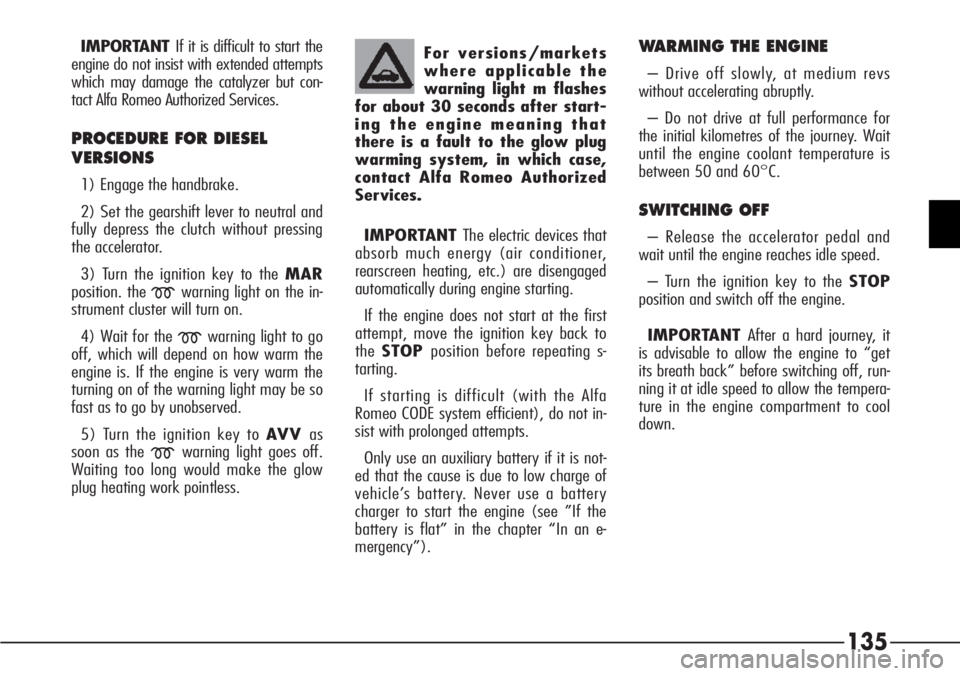
135
IMPORTANT If it is difficult to start the
engine do not insist with extended attempts
which may damage the catalyzer but con-
tact Alfa Romeo Authorized Services.
PROCEDURE FOR DIESEL
VERSIONS
1) Engage the handbrake.
2) Set the gearshift lever to neutral and
fully depress the clutch without pressing
the accelerator.
3) Turn the ignition key to the MAR
position. the
mwarning light on the in-
strument cluster will turn on.
4) Wait for the
mwarning light to go
off, which will depend on how warm the
engine is. If the engine is very warm the
turning on of the warning light may be so
fast as to go by unobserved.
5) Turn the ignition key to AVV as
soon as the
mwarning light goes off.
Waiting too long would make the glow
plug heating work pointless.IMPORTANT The electric devices that
absorb much energy (air conditioner,
rearscreen heating, etc.) are disengaged
automatically during engine starting.
If the engine does not start at the first
attempt, move the ignition key back to
theSTOPposition before repeating s-
tarting.
If starting is difficult (with the Alfa
Romeo CODE system efficient), do not in-
sist with prolonged attempts.
Only use an auxiliary battery if it is not-
ed that the cause is due to low charge of
vehicle’s battery. Never use a battery
charger to start the engine (see ”If the
battery is flat” in the chapter “In an e-
mergency”).
WARMING THE ENGINE
– Drive off slowly, at medium revs
without accelerating abruptly.
– Do not drive at full performance for
the initial kilometres of the journey. Wait
until the engine coolant temperature is
between 50 and 60°C.
SWITCHING OFF
– Release the accelerator pedal and
wait until the engine reaches idle speed.
– Turn the ignition key to the STOP
position and switch off the engine.
IMPORTANT After a hard journey, it
is advisable to allow the engine to “get
its breath back” before switching off, run-
ning it at idle speed to allow the tempera-
ture in the engine compartment to cool
down. For versions/markets
where applicable the
warning light m flashes
for about 30 seconds after start-
ing the engine meaning that
there is a fault to the glow plug
warming system, in which case,
contact Alfa Romeo Authorized
Services.
Page 139 of 272
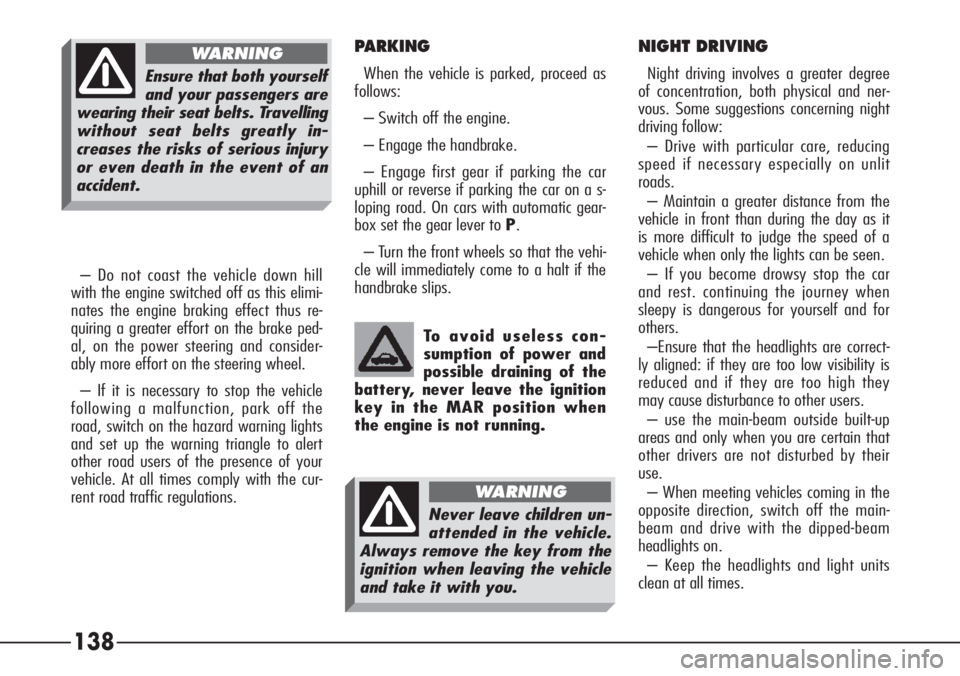
138
PARKING
When the vehicle is parked, proceed as
follows:
– Switch off the engine.
– Engage the handbrake.
– Engage first gear if parking the car
uphill or reverse if parking the car on a s-
loping road. On cars with automatic gear-
box set the gear lever to P.
– Turn the front wheels so that the vehi-
cle will immediately come to a halt if the
handbrake slips.
NIGHT DRIVING
Night driving involves a greater degree
of concentration, both physical and ner-
vous. Some suggestions concerning night
driving follow:
– Drive with particular care, reducing
speed if necessary especially on unlit
roads.
– Maintain a greater distance from the
vehicle in front than during the day as it
is more difficult to judge the speed of a
vehicle when only the lights can be seen.
– If you become drowsy stop the car
and rest. continuing the journey when
sleepy is dangerous for yourself and for
others.
–Ensure that the headlights are correct-
ly aligned: if they are too low visibility is
reduced and if they are too high they
may cause disturbance to other users.
– use the main-beam outside built-up
areas and only when you are certain that
other drivers are not disturbed by their
use.
– When meeting vehicles coming in the
opposite direction, switch off the main-
beam and drive with the dipped-beam
headlights on.
– Keep the headlights and light units
clean at all times. – Do not coast the vehicle down hill
with the engine switched off as this elimi-
nates the engine braking effect thus re-
quiring a greater effort on the brake ped-
al, on the power steering and consider-
ably more effort on the steering wheel.
– If it is necessary to stop the vehicle
following a malfunction, park off the
road, switch on the hazard warning lights
and set up the warning triangle to alert
other road users of the presence of your
vehicle. At all times comply with the cur-
rent road traffic regulations.To avoid useless con-
sumption of power and
possible draining of the
battery, never leave the ignition
key in the MAR position when
the engine is not running.Ensure that both yourself
and your passengers are
wearing their seat belts. Travelling
without seat belts greatly in-
creases the risks of serious injury
or even death in the event of an
accident.
WARNING
Never leave children un-
attended in the vehicle.
Always remove the key from the
ignition when leaving the vehicle
and take it with you.
WARNING
Page 140 of 272
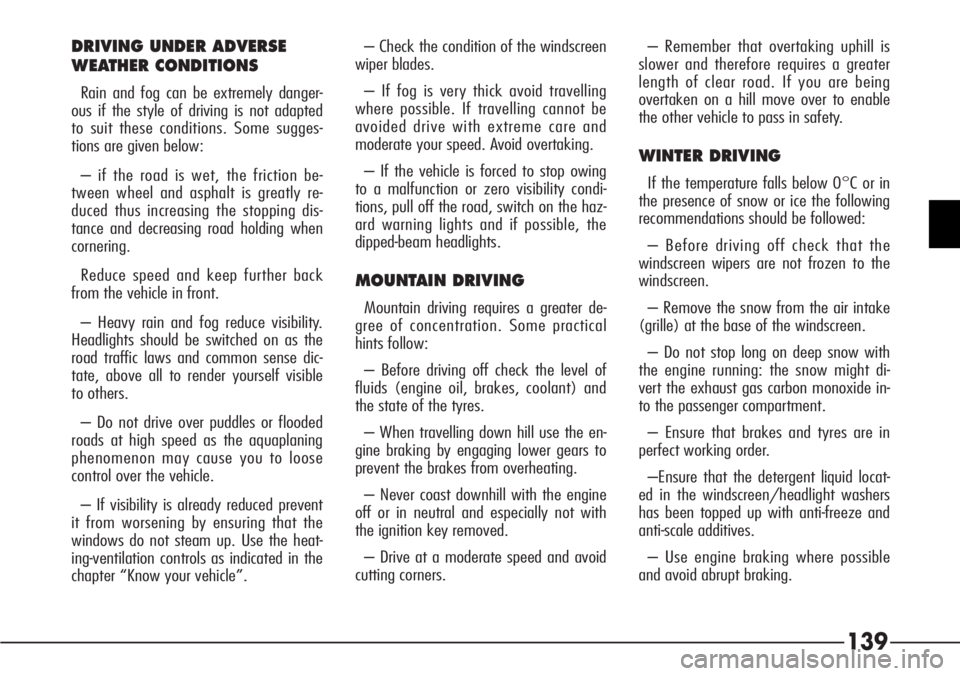
139
DRIVING UNDER ADVERSE
WEATHER CONDITIONS
Rain and fog can be extremely danger-
ous if the style of driving is not adapted
to suit these conditions. Some sugges-
tions are given below:
– if the road is wet, the friction be-
tween wheel and asphalt is greatly re-
duced thus increasing the stopping dis-
tance and decreasing road holding when
cornering.
Reduce speed and keep further back
from the vehicle in front.
– Heavy rain and fog reduce visibility.
Headlights should be switched on as the
road traffic laws and common sense dic-
tate, above all to render yourself visible
to others.
– Do not drive over puddles or flooded
roads at high speed as the aquaplaning
phenomenon may cause you to loose
control over the vehicle.
– If visibility is already reduced prevent
it from worsening by ensuring that the
windows do not steam up. Use the heat-
ing-ventilation controls as indicated in the
chapter “Know your vehicle”.– Check the condition of the windscreen
wiper blades.
– If fog is very thick avoid travelling
where possible. If travelling cannot be
avoided drive with extreme care and
moderate your speed. Avoid overtaking.
– If the vehicle is forced to stop owing
to a malfunction or zero visibility condi-
tions, pull off the road, switch on the haz-
ard warning lights and if possible, the
dipped-beam headlights.
MOUNTAIN DRIVING
Mountain driving requires a greater de-
gree of concentration. Some practical
hints follow:
– Before driving off check the level of
fluids (engine oil, brakes, coolant) and
the state of the tyres.
– When travelling down hill use the en-
gine braking by engaging lower gears to
prevent the brakes from overheating.
– Never coast downhill with the engine
off or in neutral and especially not with
the ignition key removed.
– Drive at a moderate speed and avoid
cutting corners.– Remember that overtaking uphill is
slower and therefore requires a greater
length of clear road. If you are being
overtaken on a hill move over to enable
the other vehicle to pass in safety.
WINTER DRIVING
If the temperature falls below 0°C or in
the presence of snow or ice the following
recommendations should be followed:
– Before driving off check that the
windscreen wipers are not frozen to the
windscreen.
– Remove the snow from the air intake
(grille) at the base of the windscreen.
– Do not stop long on deep snow with
the engine running: the snow might di-
vert the exhaust gas carbon monoxide in-
to the passenger compartment.
– Ensure that brakes and tyres are in
perfect working order.
–Ensure that the detergent liquid locat-
ed in the windscreen/headlight washers
has been topped up with anti-freeze and
anti-scale additives.
– Use engine braking where possible
and avoid abrupt braking.
Page 156 of 272
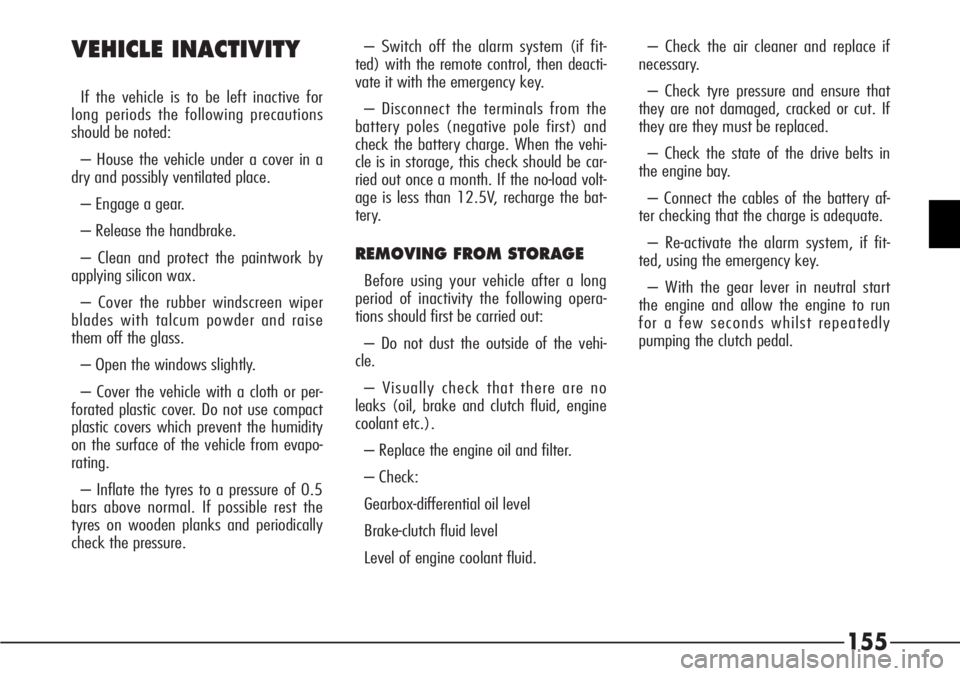
155 VEHICLE INACTIVITY
If the vehicle is to be left inactive for
long periods the following precautions
should be noted:
– House the vehicle under a cover in a
dry and possibly ventilated place.
– Engage a gear.
– Release the handbrake.
– Clean and protect the paintwork by
applying silicon wax.
– Cover the rubber windscreen wiper
blades with talcum powder and raise
them off the glass.
– Open the windows slightly.
– Cover the vehicle with a cloth or per-
forated plastic cover. Do not use compact
plastic covers which prevent the humidity
on the surface of the vehicle from evapo-
rating.
– Inflate the tyres to a pressure of 0.5
bars above normal. If possible rest the
tyres on wooden planks and periodically
check the pressure.– Switch off the alarm system (if fit-
ted) with the remote control, then deacti-
vate it with the emergency key.
– Disconnect the terminals from the
battery poles (negative pole first) and
check the battery charge. When the vehi-
cle is in storage, this check should be car-
ried out once a month. If the no-load volt-
age is less than 12.5V, recharge the bat-
tery.
REMOVING FROM STORAGE
Before using your vehicle after a long
period of inactivity the following opera-
tions should first be carried out:
– Do not dust the outside of the vehi-
cle.
– Visually check that there are no
leaks (oil, brake and clutch fluid, engine
coolant etc.).
– Replace the engine oil and filter.
– Check:
Gearbox-differential oil level
Brake-clutch fluid level
Level of engine coolant fluid.– Check the air cleaner and replace if
necessary.
– Check tyre pressure and ensure that
they are not damaged, cracked or cut. If
they are they must be replaced.
– Check the state of the drive belts in
the engine bay.
– Connect the cables of the battery af-
ter checking that the charge is adequate.
– Re-activate the alarm system, if fit-
ted, using the emergency key.
– With the gear lever in neutral start
the engine and allow the engine to run
for a few seconds whilst repeatedly
pumping the clutch pedal.
Page 168 of 272
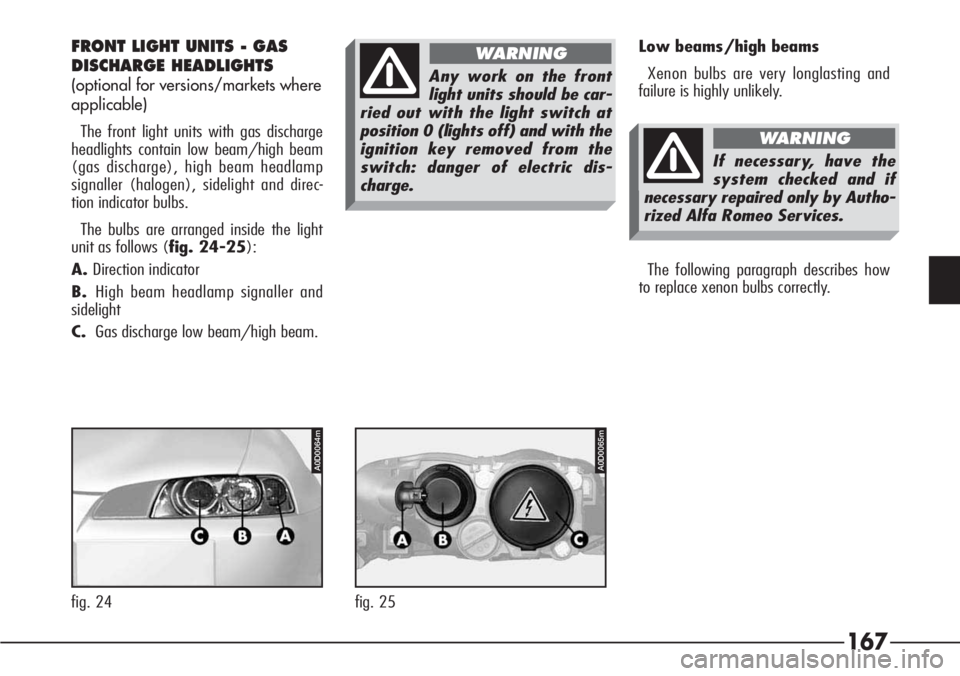
167
FRONT LIGHT UNITS - GAS
DISCHARGE HEADLIGHTS
(optional for versions/markets where
applicable)
The front light units with gas discharge
headlights contain low beam/high beam
(gas discharge), high beam headlamp
signaller (halogen), sidelight and direc-
tion indicator bulbs.
The bulbs are arranged inside the light
unit as follows (fig. 24-25):
A.Direction indicator
B.High beam headlamp signaller and
sidelight
C.Gas discharge low beam/high beam.Low beams/high beams
Xenon bulbs are very longlasting and
failure is highly unlikely.
The following paragraph describes how
to replace xenon bulbs correctly.
Any work on the front
light units should be car-
ried out with the light switch at
position 0 (lights off) and with the
ignition key removed from the
switch: danger of electric dis-
charge.
WARNING
If necessary, have the
system checked and if
necessary repaired only by Autho-
rized Alfa Romeo Services.
WARNING
A0D0064m
fig. 24
A0D0065m
fig. 25